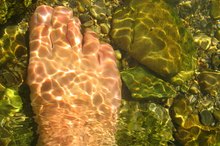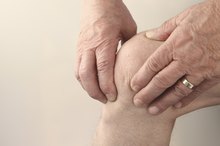What Happens If Shingles Are Not Treated with Medicine?
Physicians diagnose about 500,000 new cases of shingles in the United States each year. There is no treatment for shingles, which is a reactivation of the varicella-zoster virus that causes chickenpox; however, antiviral medications can reduce the length and severity of symptoms. In approximately 33 percent of the cases, the patient will develop severe complications, according to the Centers for Disease Control and Prevention. Without antiviral medication, problems are most likely to develop among high risk groups, such as the elderly or those with compromised immune systems. But treatment within the first two days of symptoms may reduce the likelihood of complications, such as postherpetic neuralgia, according to the Mayo Clinic 3.
Prolonged Pain
The pain associated with shingles varies from person to person. It may feel like an electric shock, a dull ache or a sharp pain. It may also be uncomfortable when clothing touches the skin in the affected area. The pain occurs before the first sign of the shingles rash and will continue after the rash develops. Medication hastens healing and reduces the length of time this pain occurs.
- The pain associated with shingles varies from person to person.
- The pain occurs before the first sign of the shingles rash and will continue after the rash develops.
Postherpetic Neuralgia
Back Pain From Shingles
Learn More
Postherpetic neuralgia occurs when the pain associated with shingles extends beyond the period that the shingles virus is active 3. The varicella-zoster virus damages the affected nerves, which leads to changes in the way the nerves perceive pain and sends those messages to the brain. Pain from postherpetic neuralgia is sharp, and the area may itch and develop weakness in the surrounding muscles 3. Headaches are also common with postherpetic neuralgia 3.
Ramsay Hunt Syndrome
Ramsay Hunt syndrome develops when the varicella-zoster virus affects the nerves in the face. The patient will typically develop blisters in the ear, roof of the mouth and other areas on the face. Muscle weakness and facial paralysis may occur as well. It is vital that someone who develops shingles on the face seek treatment. Left untreated, the patient may develop permanent damage to their hearing as well as irreversible muscle damage.
- Ramsay Hunt syndrome develops when the varicella-zoster virus affects the nerves in the face.
- The patient will typically develop blisters in the ear, roof of the mouth and other areas on the face.
Secondary Skin Infections
What Is the Incubation Period for Shingles?
Learn More
Left untreated, the areas of the skin affected by shingles may develop secondary infections. The discomfort associated with shingles leads to scratching or rubbing, which creates an opening for bacteria into the body. Even the most conscientious person may develop a secondary skin infection due to slow healing of the open blisters.
Related Articles
References
- Mayo Clinic: Postherpetic Neuralgia
- Centers for Disease Control and Prevention. Shingles (Herpes Zoster) Signs & Symptoms.
- Centers for Disease Control and Prevention. Shingles (Herpes Zoster) Signs & Symptoms.
- John AR, Canaday DH. Herpes Zoster in the Older Adult. Infect Dis Clin North Am. 2017;31(4):811-826. doi: 10.1016/j.idc.2017.07.016
- Yun H, Xie F, Baddley JW, Winthrop K, Saag KG, Curtis JR. Longterm Effectiveness of Herpes Zoster Vaccine among Patients with Autoimmune and Inflammatory Diseases. J Rheumatol. 2017;44(7):1083-1087. doi: 10.3899/jrheum.160685
- Cohen KR, Salbu RL, Frank J, Israel I. Presentation and Management of Herpes Zoster (Shingles) in the Geriatric Population. P T. 2013;38(4): 217-224, 227.
- Galetta KM, Gilden D. Zeroing in on zoster: A tale of many disorders produced by one virus. J Neurol Sci. 2015;358(1-2):38-45. doi: 10.1016/j.jns.2015.10.004
- Blank LJ, Polydefkis MJ, Moore RD, Gebo KA. Herpes zoster among persons living with HIV in the current antiretroviral therapy era. J Acquir Immune Defic Syndr. 2012;61(2):203-7. doi: 10.1097/QAI.0b013e318266cd3c
- Mallick-searle T, Snodgrass B, Brant JM. Postherpetic neuralgia: epidemiology, pathophysiology, and pain management pharmacology. J Multidiscip Healthc. 2016;9:447-454. doi: 10.2147/JMDH.S106340
- Johnson RW, Bouhassira D, Kassianos G, Leplège A, Schmader KE, Weinke T. The impact of herpes zoster and post-herpetic neuralgia on quality-of-life. BMC Med. 2010;8:37. doi: 10.1186/1741-7015-8-37
- Sampathkumar P, Drage LA, Martin DP. Herpes zoster (shingles) and postherpetic neuralgia. Mayo Clin Proc. 2009;84(3):274-80.
- Pereira LB. Impetigo - review. An Bras Dermatol. 2014;89(2):293-9. doi: 10.1590/abd1806-4841.20142283
- Gershon AA, Breuer J, Cohen JI, et al. Varicella zoster virus infection. Nat Rev Dis Primers. 2015;1:15016. doi: 10.1038/nrdp.2015.16
- Naveen KN, Pradeep AV, Kumar JS, Hegde SP, Pai VV, Athanikar SB. Herpes zoster affecting all three divisions of trigeminal nerve in an immunocompetent male: a rare presentation. Indian J Dermatol. 2014;59(4):423. doi: 10.4103/0019-5154.135548
- Opstelten W, Zaal MJ. Managing ophthalmic herpes zoster in primary care. BMJ. 2005;331(7509):147-51. doi: 10.1136/bmj.331.7509.147
- Jeon Y, Lee H. Ramsay Hunt syndrome. J Dent Anesth Pain Med. 2018;18(6):333-337. doi: 10.17245/jdapm.2018.18.6.333
- Kim SH, Choi SM, Kim BC, et al. Risk Factors for Aseptic Meningitis in Herpes Zoster Patients. Ann Dermatol. 2017;29(3):283-287. doi: 10.5021/ad.2017.29.3.283
- Saxena A, Khiangte B, Tiewsoh I, Jajoo UN. Herpes zoster encephalitis presenting as multiple cerebral hemorrhages - a rare presentation: a case report. J Med Case Rep. 2013;7:155. doi: 10.1186/1752-1947-7-155
- Teo HK, Chawla M, Kaushik M. A Rare Complication of Herpes Zoster: Segmental Zoster Paresis. Case Rep Med. 2016;2016:7827140. doi: 10.1155/2016/7827140
- American Academy of Dermatology. Cellulitis: Overview.
- American Academy of Ophthalmology. Herpes Zoster Ophthalmicus.
- Centers for Disease Control and Prevention. Shingles (Herpes Zoster): Clinical Overview. Feb 21, 2018.
- Mayo Clinic. Postherpetic Neuralgia. Sept 16, 2015.
Resources






